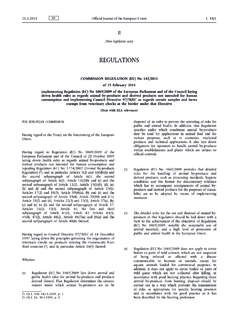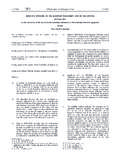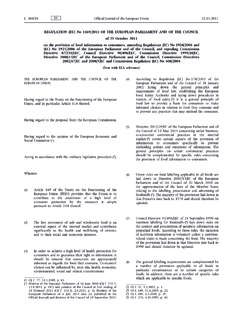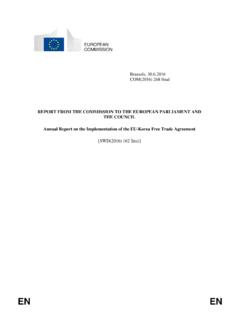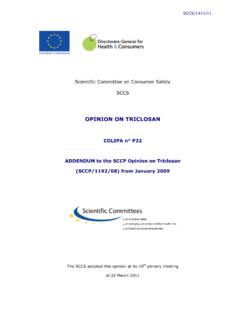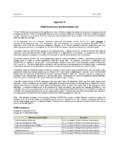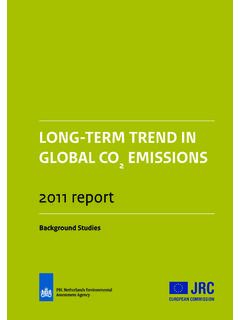Transcription of A Citation Manual for European Union Materials
1 FORDHAM. INTERNATIONAL. LAW JOURNAL. Volume 34 2010 2011 . A Citation Manual for European Union Materials 2010- 2011 Edition Contents I. Introduction & 5. A. What is the European Union ? .. 5. B. A Brief History of the EU .. 6. C. EU 7. D. Selected Resources For EU Research .. 7. II. Where to Find EU Documents .. 9. III. A. Overview of EU Treaties ..10. B. Major EU Treaties ..10. 1. Consolidated Versions of the Treaties ..11. 1a. Treaty on European Union ( TEU post-Lisbon ) ..11. 1b. Treaty on the Functioning of the European Union ( TFEU ) ..12. 1c. Treaty on European Union ( TEU pre-Lisbon ) ..12. 1d. Treaty Establishing the European Community ( EC Treaty ) ..12. 1e. Parallel Citation System for Consolidated Versions of the 1f. References to prior 2.
2 Foundational or Constitutive Treaties ..14. 2a. Treaty of Maastricht's Treaty on European Union ..14. 2b. Treaty Establishing the European Economic Community ( EEC Treaty ; popular name: Treaty of Rome ) ..14. 2c. Treaty Establishing the European Atomic Energy Community ( Euratom ) ..15. 2d. Treaty Establishing the European Coal and Steel Community ( ECSC Treaty ) ..15. 3. Treaties amending the Constitutive Treaties ..15. 3a. Single European Act ( SEA ) ..16. 3b. Treaty of Maastricht see 2a supra ..16. 3c. Treaty of Amsterdam ..16. 3d. Treaty of Nice ..17. 4. Other Treaties ..18. 5. Draft Treaty Establishing a Constitution for Europe (NEVER RATIFIED) ..18. C. Charter of Fundamental Rights of the European Union ..18. IV. Court of Justice and General Court Cases.
3 20. Contents - 2. A. Overview ..20. B. Basic Citation Forms ..21. 1. Cases in ..21. 2. Cases Not Yet Published in 3. Joined Cases ..21. 4. Cases with "Popular Short Names" ..22. 5. Cases Citing not to the Decision, but to the Summary of Judgment or Other Supplementary 6. Opinions of Advocates General ..23. 6a. Reported Decisions ..23. 6b. Decision not yet Published in ..24. 6c. ECJ Decision not yet Issued ..24. 7. Pending Cases ..24. V. Directives, Regulations, and Other Legislation ..25. A. Overview ..25. B. Directives and Regulations ..25. 1. Standard Citations ..25. 1a. Parliament and Council Directives ..25. 1b. Council Directives ..26. 1c. Council Regulations ..26. 1d. Corrected Version in Citation ..26. 1e. Amending or Codifying Directives or Regulations.
4 27. C. D. Resolutions, Notices, Communications, and Other Legislation ..27. 1. Resolutions ..28. 1a. Council Resolution ..28. 1b. European Parliament Resolution ..28. 2. Notices ..28. 3. Communications/Proposals/Guidelines ..28. 3a. Draft Communications/Proposals/Guidelines ..29. VI. Commission and Council Decisions ..30. A. Basic Citation Form ..30. B. Examples ..30. Contents - 3. 1. Decisions only in ..30. 2. Decisions Not Reported in Full, but Noted in the ..30. 3. Unreported 4. Decision Summaries ..31. VII. Miscellaneous Materials ..32. A. General Report on the Activities of the European Communities ..32. B. Bulletin of the European Communities and Bulletin of the European Union ..32. C. Commission "COM" or "SEC" Documents ..33.
5 D. Commission Press Releases ..33. E. Commission Competition Contents - 4. I. Introduction & Overview The Fordham International Law Journal has long prided itself on being at the forefront of US legal scholarship on the European Community ("EC") or, as it is now called, the European Union ("EU"). For this reason, it is important to understand why the Citation format for EC and EU Materials used by the Journal is different from that used by the Bluebook, and why following this Manual is important to ensure accuracy. A. WHAT IS THE European Union ? The EU is a unique political structure, currently composed of twenty-seven nations, a complex supranational organization that has federal aspects analogous to the US. The countries that make up the EU ("Member States") remain independent sovereign nations, but they have ceded a part of their sovereignty in order to achieve a common market and other goals, as well as a global influence that none of them could have on their own ( , within the World Trade Organization).
6 This concept may seem fairly abstract, but in practical terms, it means that citizens of EU. countries essentially no longer have barriers to living, working, studying, or retiring in other European countries. In the EU, citizens can travel across national borders without showing a passport (except to or from the UK and Ireland), and in many Member States, can compare prices using a unified currency ("Euro"), and can study, work, or retire in any European country they choose. For many Europeans, the EU means more freedom, lower prices, and greater power on the international level, as Member States increasingly speak with one voice to the rest of the world. The inability to classify the EU neatly into an existing political or legal framework makes it the subject of much legal analysis and, thus, many law journal articles.
7 Moreover, other articles provide information on EU substantive law to American lawyers who engage in legal practice within or relating to the EU. Also, some articles provide valuable comparative analysis with parallel US rules and policies. The EU has four important political institutions: the Commission, Council, European Council, and Parliament, each with distinct roles and powers. The Court of Justice, together with its accessory General Court (formerly the Court of First Instance) has produced an enormous body of case law. It is important to remember that Court doctrines hold that EU law, based on the treaties, is quite distinct from traditional public international law. For these and other reasons, the Citation of EU Materials needs to be detailed and different from traditional Citation .
8 It is not enough that the reader may simply locate the document or source; it is essential that the reader and/or scholar know exactly which source is being cited and in what manner. Failure to properly cite invites mischaracterizations and inadvertent omissions that result in reduced accuracy and increased difficulty in finding reliable source material . Thus, the Fordham International Law Journal adheres to a strict set of Citation standards for EU Materials that differs from normal Citation guidelines in that it requires more detailed Introduction & Overview - 5. information both in the original Citation and in subsequent cites. Though more time consuming, this formulation ensures our readers have the most information readily available and can rely upon the accuracy of the Citation .
9 B. A BRIEF HISTORY OF THE EU. The historical roots of the European Union lie in the aftermath of World War II. The continent had witnessed one of the most destructive wars in recorded history, and had to also deal with the emerging superpowers of the United States and the Soviet Union . After WWII, France decided that the best way to keep the peace with Germany was to become economically linked, together with Italy and the Benelux nations. The 1953 European Coal and Steel Community ("ECSC") integrated the coal and steel industries of France and Germany in order to stabilize their relations. The success of the ECSC led the political leadership of the six initial Member States to enter into the Treaty of Rome on March 25, 1957 which launched in 1958 the European Economic Community ( EEC ).
10 Subsequently, the Treaty of Maastricht created the European Union ( EU ) as an over-arching structure in 1993, and modified substantially the EEC, renamed the European Community ( EC ). The Treaties of Amsterdam in 1999 and Nice in 2003 made important amendments. The Treaty of Lisbon, effective December 1, 2009, substantially amended the initial Maastricht Treaty on European Union and absorbed the EC into the European Union . In the early years, the EEC mainly dealt with trade and the economy. In 1973 the process of enlargement began when the UK, Denmark, and Ireland joined the EEC. In the 1980s Greece, Portugal, and Spain all joined and were followed by Austria, Finland, and Sweden in 1995. In May 2004, ten new countries joined the European Union , with two others in 2007, thus bringing the number of Member States to twenty-seven.
